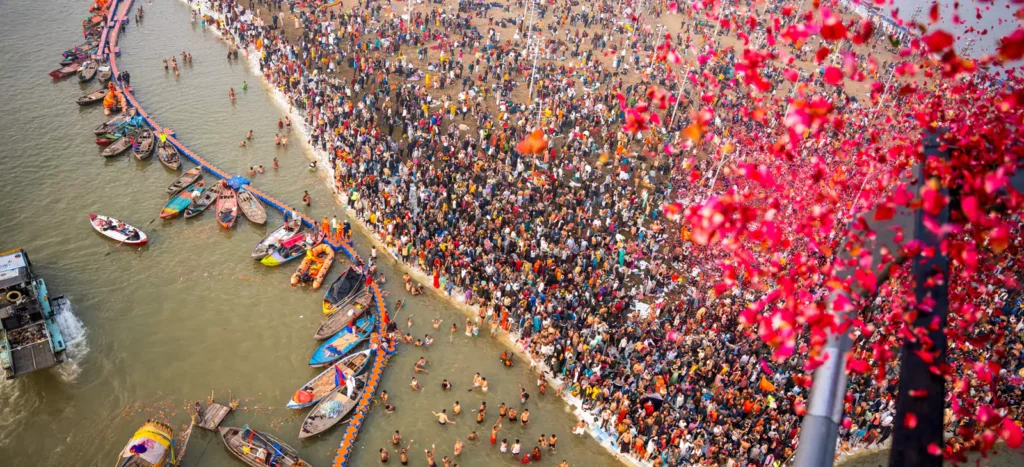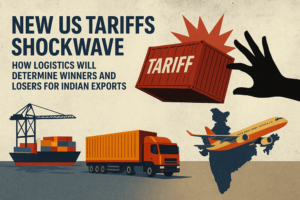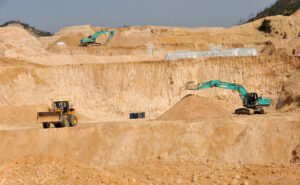
Introduction
When millions of pilgrims converge at the confluence of three sacred rivers in India, what unfolds is not just the world’s largest religious gathering but also one of humanity’s most remarkable logistical achievements. The Maha Kumbh Mela represents a temporary mega-city that materializes within weeks, functions seamlessly for a month, and then disappears—leaving behind economic ripples worth billions of dollars.
How does all this get done? Let’s dive into the unparalleled logistical marvel of the Maha Kumbh Mela.
The Economic & Logistical Scale of Maha Kumbh
The 12-year Maha Kumbh Mela generates approximately $12-16 billion in economic activity, while the 6-year Ardh Kumbh creates around $2 billion—all concentrated within a single month. The 2019 Prayagraj Kumbh Mela alone had an estimated total economic impact of ₹1.2 lakh crore ($16 billion), with logistics contributing between ₹18,000-30,000 crore ($2.5-4 billion).
Planning and Execution: A Three-Tiered Governance Model
The logistics of Kumbh Mela are handled by a structured approach involving multiple stakeholders:
- Central Government: Provides financial backing and inter-state coordination.
- State Government: Takes primary responsibility for infrastructure development.
- District Administration: Handles on-ground implementation.
- Kumbh Mela Authority: Brings together 30+ government departments, including railways, police, public works, health, sanitation, and electricity.
While the government provides the framework, the private sector brings execution excellence:
- Logistics Giants: Mahindra Logistics, TCI, and DHL manage specific supply chain corridors.
- FMCG Companies: Hindustan Unilever, ITC, and others deploy specialized rural distribution models.
- Technology Partners: TCS, Infosys, and startups develop crowd management, supply tracking, and safety applications.
- Temporary Infrastructure Specialists: Experts in pop-up cities, many of whom started with Kumbh before expanding globally.
Key Logistical Pillars of Kumbh Mela
1. Transport & Mobility (₹8,000-12,000 crore)
- Indian Railways operates 1,000+ special trains, transporting over 40 million passengers.
- Road transport surges with 20,000+ additional buses and private vehicles.
- Cycle rickshaws become critical last-mile connectors, with earnings rising tenfold.
- At peak Kumbh, daily passenger volume exceeds the annual traffic of many international airports.
2. Goods Movement & Supply Chain (₹3,000-5,000 crore)
- 30,000 metric tons of food grains, 15,000 metric tons of vegetables, and 10,000 metric tons of milk products are transported.
- Unique religious requirements involve:
- Temperature-controlled transport for specific offerings.
- Just-in-time delivery for perishables.
- Dedicated supply chains for ritual ingredients.
3. Temporary Storage & Warehousing (₹2,000-4,000 crore)
- Over 100 temporary warehouses and cold storage facilities are set up.
- Dynamic inventory systems balance pilgrim movement patterns with supply availability.
4. Event Logistics & Infrastructure (₹5,000-9,000 crore)
- Construction of 4,000+ tents to house officials, pilgrims, and vendors.
- Setup of 122,000 toilets, 40,000+ electrical connections, and 1,200+ CCTV cameras for security.
- Pontoon bridges are built to withstand millions of crossings.
Logistics Innovations Pioneered by Kumbh Mela
The extreme demands of Kumbh have driven innovations now used globally:
- RFID Pilgrim Tracking: First deployed in Kumbh 2013, now used at global events.
- Modular Infrastructure: Quick-deploy sanitation systems, now used in disaster relief efforts.
- Mobile App Ecosystem: Integrated apps for lost-and-found, food safety, and navigation.
- Drone-Based Supply Monitoring: Aerial surveillance for optimizing distribution.
Challenges & Future Opportunities in Kumbh Logistics
Despite its success, the Kumbh Mela logistics system faces evolving challenges:
- Environmental Sustainability: Reducing plastic waste and river pollution remains a top priority.
- Last-Mile Connectivity: Enhancing integration with informal transport systems for rural pilgrims.
- Technology Integration: Balancing modern systems with traditional practices to ensure accessibility.
- Climate Resilience: Preparing for extreme weather disruptions to maintain smooth operations.
Kumbh Mela vs. Global Mega-Events
For scale, consider this:
- The Olympics hosts 11,000 athletes and 500,000 spectators over two weeks.
- Kumbh 2019 managed 240 million visitors in a single month—equivalent to 20 simultaneous Olympics with 480 times the attendance!
- Kumbh 2025 has already set new records with over 500 million attendees.
Conclusion: Lessons for Global Supply Chains
The Maha Kumbh Mela stands as a testament to India’s capability to execute the largest peaceful gathering through a mix of ancient wisdom and modern supply chain expertise. Each edition becomes more efficient, providing a living laboratory for mega-event management.
As global supply chains face increasing disruptions, the agility, scalability, and resilience demonstrated at Kumbh offer valuable lessons for businesses worldwide. The ability to create a fully functional, billion-dollar ecosystem for just one month and dismantle it with precision underscores the efficiency of India’s logistics sector.
For businesses involved in freight forwarding, LCL, FCL, and air cargo, the expertise applied at Kumbh can inspire solutions for tackling high-pressure logistics scenarios across industries. If your business needs smart logistics solutions, get in touch with our expert freight forwarding team today!












